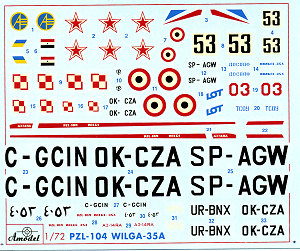
| KIT: | A-Model 1/72 PZL-104 "Wilga" |
| KIT #: | 7232 |
| PRICE: | $11.70 from GreatModels |
| DECALS: | Seven options |
| REVIEWER: | Scott Van Aken |
| NOTES: |

| HISTORY |
The PZL-104 was designed mainly for use in sports aviation, especially for glider-towing and parachute training. The prototype of the initial Wilga 1 variant was first flown on April 24, 1962. It used a Polish 220 hp flat engine PZL WN-6RB. The Wilga 1 revealed numerous faults, the most serious of which were that it was too heavy and the crew could not see a towed glider. As a result, the airframe was thorougly redesigned by a team led by Bronisław Żurakowski and Andrzej Frydrychewicz, retaining only the general composition and part of wings in common with the initial design. A completely new slimmer, strengthened fuselage was provided, which offers an excellent view for the crew. Side doors open upwards and it is possible to fly with doors open for a better observation or performing parachute jumps.
The new variant, PZL-104 Wilga 2, flew first on August 1, 1963. A short production run followed (later converted to the Wilga C and Wilga 3 configurations). On December 30, 1963 the Wilga C (or Wilga 2C), an export variant for Indonesia, was flown, powered by an imported 225 hp flat engine Continental O-470. While the Wilga 2 airframe proved a successful design, the WN-6 engine was not fully reliable and did not enter serial production. As a result, it was decided to use a radial engine, the 260 hp Ivchenko AI-14R; this led to the PZL-104 Wilga 3 variant, which first flew on December 31, 1965. The new engine was more powerful, but it spoilt the previously clean and slim fuselage lines; nonetheless, the new variant was successful. Especially high was its rate of climb - maximum 11 m/s with minimal load. Another variant, the Wilga 32, was an improved small series export variant with Continental flat engine, produced also in Indonesia as Gelatik. After producing 13 Wilga 3s, there were some improvements made, most notably a landing gear base increased from 2.12 m to 2.83 m to improve stability. An improved model, designated PZL-104 Wilga 35, first flew on June 29, 1967, then it entered mass production. Most numerous variant of Wilga 35 was the utility plane Wilga 35A, others were built in small numbers or remained prototypes.
From 1979 there was produced the Wilga 80, certified for the US market. From the late 1990s there was developed the PZL-104M Wilga 2000 family, powered with Lycoming flat engines and with improved aerodynamics.
Over 1000 of all types of the Wilga have been built, including 935 of the Wilga 35 and 80, which made it the most numerous-built plane of Polish design. EADS-PZL announced on the web page, that it had decided to stop the production of the PZL-104MA Wilga 2000.
| THE KIT |
 In
line with other A-Model kits, this one is semi-soft injected plastic on large
sprues. The parts themselves all have a bit of flash (or overly thick mold
seams), though are well detailed. My copy had sink areas on the tips of the
wings where the plastic is particularly thick. The rest of the kit seems fine.
There are four sprues; two in brown plastic, one in white and one clear. The
clear parts are rather thick a
In
line with other A-Model kits, this one is semi-soft injected plastic on large
sprues. The parts themselves all have a bit of flash (or overly thick mold
seams), though are well detailed. My copy had sink areas on the tips of the
wings where the plastic is particularly thick. The rest of the kit seems fine.
There are four sprues; two in brown plastic, one in white and one clear. The
clear parts are rather thick a nd
a bit cloudy in some instances. The only optional part is a large exhaust with
muffler that is to be used on some of the options.
nd
a bit cloudy in some instances. The only optional part is a large exhaust with
muffler that is to be used on some of the options.
The instructions are well done though pretty much all in Russian. The five construction sequences are well drawn and show where all the bits go. Coloring information is not provided for the interior or given at all during the construction of the kit. It s only provided during the painting and decal markings portion of the sheet and then in generic and Humbrol references. There are no fewer than 8 markings options, most of them red and white. There is a Russian military version, a Ukranian civil scheme, Polish civil and military aircraft, Canadian civil, Czech civil, and Egyptian military option. The Polish military option is in a two greens camouflage while the Egyptian military scheme is in sand with a red forward cowling. The decals are well printed, matte and have very large clear carrier film that will need to be trimmed as it joins several of the markings. My past experience with A-model decals has been generally good, but one has to use them with care.
| CONCLUSIONS |
I have a penchant for the unusual when it comes to kits, so it is natural that the Wilga would draw my attention. Though not your standard swoopy fighter, it has a charm of its own. I know that the kit will require more modeling skill than the norm, but the end result will be something one just doesn't see every day.
| REFERENCES |
July 2007
You can find this and other interesting A-model kits on discount at GreatModels
If you would like your product reviewed fairly and quickly by a site that has over 350,000 visitors a month, please contact me or see other details in the Note to Contributors.